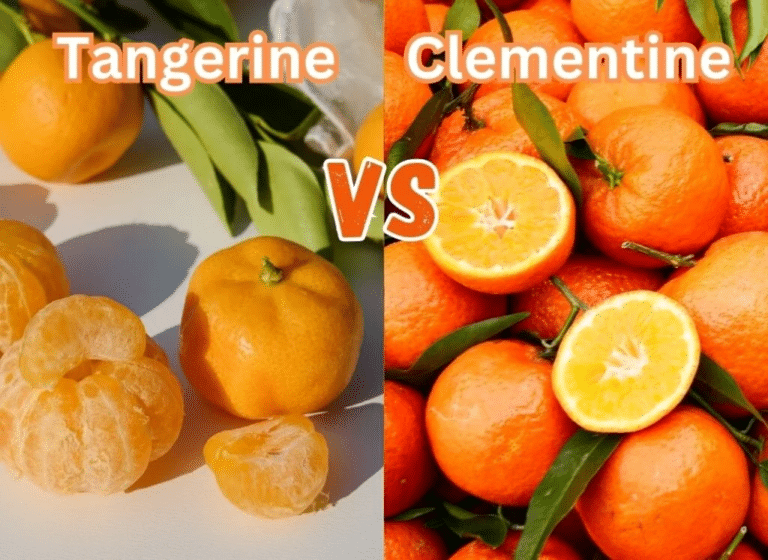Tangerines and clementines, two vibrant and juicy citrus fruits that arouse our senses with their tangy sweetness.
But what sets these lovely fruits apart?
From their captivating colors to their enticing flavors, join us as we delve into the delightful world of tangerines and clementines.
Discover their similarities, uncover their differences, and unlock the secret to preserving their mouthwatering freshness.
Brace yourself for a tantalizing journey that will leave your taste buds yearning for more.
clementine vs tangerine
In comparing clementines and tangerines, both fruits share similar characteristics such as small size, few to no seeds, sweet flavor, and easy-to-peel skin.
Tangerines have darker reddish-orange, soft, pebbly skin, while clementines are slightly smaller with brighter orange color and smoother, shinier skin.
Clementines are even easier to peel than tangerines.
Nutritionally, both fruits are low in calories, high in vitamin C, and contain carotenoid compounds and flavonoids.
They can be consumed as snacks or added to salads, and their peels can be used in cooking and tea making.
Both fruits should be consumed quickly and can benefit from refrigeration to extend their freshness.
Key Points:
- Clementines and tangerines have similar characteristics such as:
- Small size
- Few to no seeds
- Sweet flavor
- Easy-to-peel skin
- Tangerines have:
- Darker reddish-orange, soft, pebbly skin
- Clementines are:
- Slightly smaller
- Brighter orange color
- Smoother, shinier skin
- Clementines are even easier to peel than tangerines.
- Both fruits are:
- Low in calories
- High in vitamin C
- Contain carotenoid compounds and flavonoids.
- They can be consumed as snacks or added to salads.
- Their peels can be used in cooking and tea making.
- Both fruits should be consumed quickly and can benefit from refrigeration to extend their freshness.
clementine vs tangerine – Watch Video


Pro Tips:
1. Clementines and tangerines are actually two different types of mandarin oranges. While they may appear similar, clementines are usually seedless and have a slightly sweeter taste compared to tangerines.
2. The name “clementine” was given to this particular variety of mandarin orange as a tribute to its discoverer, Father Clément Rodier, who first cultivated it in Algeria in the late 19th century.
3. Tangerines are believed to have originated in Tangier, Morocco, hence the name “tangerine.” However, they were likely brought to Europe from China during ancient trade routes.
4. Clementines and tangerines are both excellent sources of vitamin C, but clementines are known to contain slightly higher levels of this essential nutrient, making them a great immunity booster during the colder months.
5. Unlike tangerines, clementines are specifically bred to be seedless. This makes them a popular choice for snacking because you don’t have to worry about removing or accidentally biting into any seeds.
Similar Characteristics Of Tangerines and Clementines
Tangerines and clementines are frequently compared due to their similarities. Both fruits are hybrids of the mandarin fruit and share several characteristics. They are small in size, making them a convenient snack option. Additionally, both tangerines and clementines are known for having either few or no seeds, which contributes to their overall appeal. The flavor of both fruits is also quite similar, characterized by a pleasant sweetness that is enjoyed by many. Another shared attribute is their easy-to-peel skin, which allows for effortless consumption. With their similarities in size, seed content, taste, and peelability, tangerines and clementines are highly favored by fruit enthusiasts and health-conscious individuals alike.
Tangerines: Native To Southeast Asia
Tangerines, also known as mandarins in the United States, are native to Southeast Asia. This citrus fruit got its name from the Moroccan port of Tangier, a major export hub. Tangerines have a distinctive reddish-orange hue and a soft, pebbly skin. Unlike larger orange varieties, tangerines are highly cold-tolerant and can be grown in a variety of regions. They have gained global popularity due to their delicious taste and convenience.
Tangerines Vs Clementines: Skin Comparison
While tangerines and clementines share a similar overall appearance, their skin differs in certain aspects. Tangerines have a darker reddish-orange coloration on the outside and a soft, pebbly texture. This roughness distinguishes them from other citrus fruits. On the other hand, clementines possess a brighter orange color with a smoother and shinier skin. The vibrant and glossy appearance of clementines can be attributed to their genetic makeup and specific varietal traits. These slight differences in skin characteristics make it easier to identify and differentiate between tangerines and clementines when purchasing or consuming these fruits.
Clementines: Smaller Size And Brighter Skin
Clementines, a variety of the mandarin fruit, have gained popularity in recent years. One standout characteristic of clementines is their smaller size compared to tangerines. This makes them a great option for individuals who prefer smaller portions or want to manage their snacking. Additionally, clementines have a vibrant, bright orange color that is closely associated with their delicious taste. Due to their compact size and appealing appearance, clementines have developed a substantial following among citrus fruit enthusiasts.
Ease Of Peeling: Clementines Vs Tangerines
One of the most significant advantages of both tangerines and clementines is their easy-to-peel skin. However, in terms of peelability, clementines take the crown. With their softer and thinner skin, clementines are incredibly easy to peel. The peel almost effortlessly separates from the fruit, making them a convenient option when on the go or looking for a quick snack. While tangerines are also relatively easy to peel, clementines surpass them in this regard. The experience of peeling a clementine is often described as a smooth and satisfying process, contributing to the overall enjoyment of consuming this fruit.
- Clementines have softer and thinner skin compared to tangerines
- The peel of clementines effortlessly separates from the fruit
- Peeling a clementine is often described as a smooth and satisfying process
“The experience of peeling a clementine is often described as a smooth and satisfying process, contributing to the overall enjoyment of consuming this fruit.”
Seasonal Availability Of Tangerines And Clementines
Tangerines and clementines are fruits that exhibit seasonal availability. These citrus delights are typically abundant from November through April, making them a wintertime favorite. The peak season for tangerines and clementines varies slightly depending on the region, but both fruits can be readily found in most grocery stores during these months. Their availability during the colder months adds to their appeal, as they provide a burst of freshness and vibrant flavor when other fruits may be scarce. It is important to note that the perishability of these fruits means they should be consumed promptly, and refrigeration can help extend their freshness.
Nutritional Profile Of Tangerines And Clementines
When it comes to nutrition, tangerines and clementines share similar profiles. Both fruits are low in calories and fat, making them an excellent option for those seeking a healthy snack. In an average-sized piece, tangerines and clementines provide approximately 40 calories, 1 gram of protein, and less than 1 gram of fat.
These fruits, however, offer a moderate amount of carbohydrates, with around 10 grams per serving. The nutritional value of tangerines and clementines lies in their vitamin and mineral content, especially vitamin C.
- Low in calories and fat
- Approx. 40 calories per serving
- 1 gram of protein
- Less than 1 gram of fat
- Moderate amount of carbohydrates (around 10 grams)
- Rich in vitamin C
“Tangerines and clementines are not only delicious but also packed with essential vitamins and minerals.”
Vitamin C Content In Tangerines And Clementines
Tangerines and clementines are rich sources of vitamin C, which is essential for a healthy immune system and various bodily functions. While both fruits provide this vital nutrient, clementines have a slight edge over tangerines in terms of vitamin C content. Just two clementines can provide more than the recommended daily intake of vitamin C for an average adult. This makes clementines an excellent choice for those looking to boost their immune system and overall well-being. The high vitamin C content in both tangerines and clementines makes them a valuable addition to any diet.
- Tangerines and clementines are rich in vitamin C
- Clementines have higher vitamin C content compared to tangerines
- Two clementines can provide more than the recommended daily intake of vitamin C for an average adult
- Excellent choice for boosting the immune system and overall well-being
- Valuable addition to any diet
Carotenoid Compounds And Antioxidants In Both Fruits
Tangerines and clementines are rich in carotenoid compounds, which serve as important vitamin A precursors and antioxidants in our bodies. These compounds are responsible for the vibrant orange color of these fruits. The primary carotenoid present in mandarin oranges, including tangerines and clementines, is beta-cryptoxanthin. This powerful antioxidant promotes cellular health and provides protection against harmful free radicals. It is important to emphasize that consuming the whole fruit, rather than just the juice, ensures a higher intake of beneficial carotenoids. Incorporating tangerines and clementines into your diet can provide you with the antioxidant benefits that these fruits offer.
- Tangerines and clementines possess carotenoid compounds, acting as vitamin A precursors and antioxidants.
- The major carotenoid found in mandarin oranges is beta-cryptoxanthin.
- Consuming the whole fruit ensures a higher intake of valuable carotenoids.
Fiber Content And Health Benefits Of Tangerines And Clementines
Tangerines and clementines, like other citrus fruits, contain a significant amount of fiber. This fiber is predominantly soluble, comprising approximately 65-70% of the total fiber content in both fruits. Soluble fiber plays a crucial role in promoting healthy digestion and potentially lowering cholesterol levels. By including tangerines and clementines in the diet, individuals can enjoy the digestive benefits of the soluble fiber while indulging in a delicious snack.
Additionally, these fruits can contribute to improved heart health, bone health, and a well-rounded diet.
- Tangerines and clementines provide a sweet and convenient snacking option with their small size, easy-to-peel skin, and few to no seeds.
- Both fruits are packed with essential nutrients, including vitamin C, carotenoids, and fiber, contributing to their overall health benefits.
“Whether you choose tangerines or clementines, both fruits are excellent choices for enhancing your diet and enjoying the delightful flavors of the citrus world.”
Remember to savor these fruits during their seasonal availability and consider exploring new ways to incorporate them into your culinary adventures, such as using their peels in cooking or preparing homemade marmalade.

You may need to know these questions about clementine vs tangerine
Are clementines better than tangerines?
While both clementines and tangerines are delightful citrus fruits, their slight differences make for unique experiences. Clementines, with their smaller size and sweeter taste, offer a convenient and indulgent snacking option. Their easy-to-peel nature makes them perfect for on-the-go consumption. On the other hand, tangerines encompass a tangier flavor profile that adds a delightful zing to salads or can be transformed into delectable homemade marmalade. Ultimately, the choice between the two depends on personal preference and how one wishes to enjoy these sweet and healthy treats throughout the winter.
Are cuties tangerines or clementines?
CUTIES® are not specifically tangerines or clementines, but rather a combination of two mandarin varieties: Clementine mandarins and W. Murcott mandarins. Clementine mandarins are found from November to January, while W. Murcott mandarins are available from February to April. These distinctive mandarins, known as CUTIES®, are renowned for their irresistible taste and portability, making them an ideal snack no matter the time or place.
Which is sweeter mandarins or clementines?
Mandarins and clementines both offer delightful sweetness, yet clementines tend to edge out as the sweeter choice. While both fruits are known for their juicy and less acidic nature compared to oranges, clementines possess a slightly higher level of sweetness. The distinct flavor profile of clementines often features an intense, honey-like sweetness that sets them apart as a favored treat for those with a sweet tooth. Nonetheless, both mandarins and clementines provide a delectably sweet citrus experience.
What tastes better clementines or mandarins?
One can argue that the taste preferences for clementines versus mandarins are subjective. However, for those with a sweet tooth, clementines tend to be the preferred choice due to their intensely sweet flavor. On the other hand, mandarins offer a more aromatic experience, providing a delightful combination of citrusy and tangy notes. Ultimately, the decision between clementines and mandarins comes down to personal taste preferences.
Reference source
https://www.sandjmandarins.com/whats-the-difference-between-oranges-mandarins-satsumas-clementines-tangerines/
https://www.healthline.com/nutrition/tangerine-vs-clementine
https://cutiescitrus.com/faq/
https://www.gardenbetty.com/mandarin-oranges-vs-clementines/



